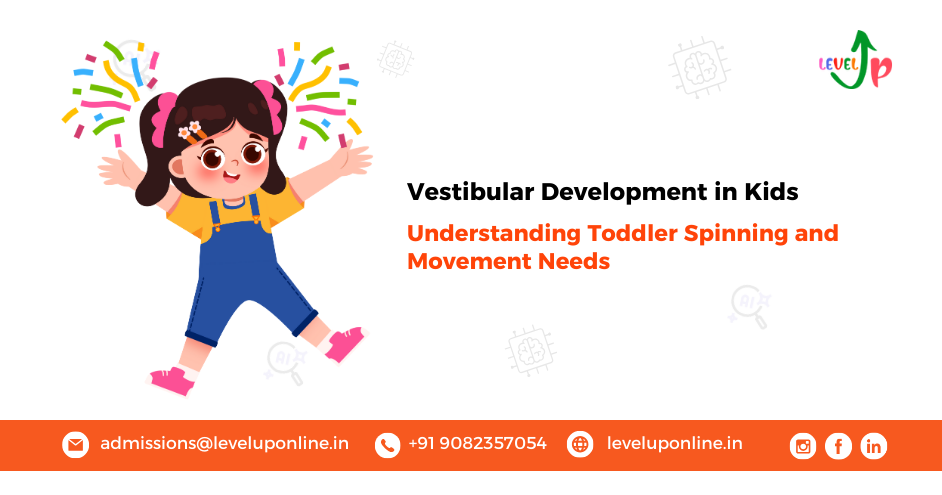Introduction
Imagine your 18-month-old suddenly discovering the joy of twirling in circles—arms wide open, giggles filling the air, and a final tumble to the floor. What looks like a playful moment is actually an important part of vestibular development in kids, shaping the way a child learns to move, balance, and interact with the world.
The Science Behind the Spin: How the Inner Ear Fuels Movement
Hidden inside each ear is a tiny but powerful balance system—the vestibular apparatus. This fluid-filled structure works like a natural gyroscope, constantly sending information to the brain about head position, movement direction, and spatial awareness.
When toddlers spin, the motion causes the fluid in the vestibular system to shift, sending rapid-fire signals to the brainstem and cerebellum. These messages help build the neural connections needed for balance, coordination, and spatial reasoning. In other words, every spin is a workout for the brain as well as the body.
The vestibular system also works hand-in-hand with vision, muscle coordination, and even emotional regulation. This explains why spinning can either calm a restless child or energize a sluggish one—it’s the brain finding the balance it needs.
Why Toddlers Love Spinning: A Perfect Developmental Stage
The toddler years create an ideal stage for spinning to take center stage. Their vestibular systems are still developing and extra sensitive, meaning they crave strong movement input.
At this stage, the parts of the brain that trigger nausea from spinning are not fully developed, so toddlers can spin much longer without feeling sick. This is nature’s way of allowing them to get the movement their brains require without negative effects.
Experts often call this “sensory hunger”—a built-in need for specific types of sensory input. For young children, rotational movement feeds this hunger, helping them regulate their bodies and emotions.
Proprioception—the body’s ability to sense its position in space—also benefits during spinning. Each rotation helps children fine-tune their awareness of where their body starts and ends, building the foundation for confident movement and motor skills.
ECCE Vestibular Development: More Than Just Balance
vestibular development in kids influences far more than a child’s ability to stand or walk straight. Studies show that early movement experiences can boost skills like reading readiness, math reasoning, and focus.
The vestibular system shares pathways with parts of the brain that process language. This means children who regularly engage in spinning and other movement activities often develop speech and language skills more quickly.
Eye coordination also improves through vestibular activities. Smooth visual tracking, essential for reading, relies heavily on strong vestibular function. Children exposed to enough rotational movement often read more fluently later on.
Even executive function—skills like memory, problem-solving, and self-control—gets a boost when children engage in movement that challenges their balance and coordination.
Supporting Spinning Safely
Once you understand how spinning supports vestibular development in kids, it’s easier to see it as beneficial rather than disruptive. Instead of stopping children from spinning, adults can make it safer and more enriching.
Outdoors, grassy fields or gentle slopes provide safe areas for spinning and falling. Indoors, soft mats, carpeted floors, or sensory playrooms can offer safe movement spaces.
Pay attention to when spinning happens most. Many children spin more during transitions, moments of stress, or when they feel bored—suggesting it helps them self-regulate.
Special equipment like sit-and-spin toys, spinning stools, or disc swings can give controlled rotational input while minimizing the risk of injury. These tools can also help gradually build tolerance for children who are sensitive to spinning.
When to Seek Professional Advice
Most spinning is a healthy part of vestibular development in kids, but there are times to consult a professional. Signs that may warrant an occupational therapy evaluation include:
1. Spinning excessively without stopping, even when uncomfortable
2. Avoiding any rotational movement altogether
3. Spinning combined with self-harming behaviors
4. Spinning dominating play to the exclusion of other activities
A therapist trained in sensory integration can assess whether a child’s spinning is supporting or hindering their development and provide targeted strategies if needed.
Spinning as “Brain Fuel”
In many ways, spinning is one of nature’s most efficient ways to strengthen the brain. Each turn helps fine-tune balance, coordination, sensory integration, and even cognitive skills.
By creating safe, supportive environments for spinning, we can respect children’s instinctive need for movement while promoting healthy vestibular development in kids Far from being a meaningless habit, spinning is a sign that the brain and body are working together to grow stronger.
The next time you see a toddler spin until they drop, know that you’re watching brain-building in action—every turn laying down the pathways for a lifetime of learning, movement, and confidence.


